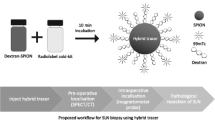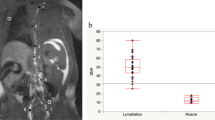Abstract
The inter- and intralymphonodal distribution of IV-administered superparamagnetic iron oxide (SPIO) particles as a lymphographic contrast agent for MRI was studied in various animal models in rats and rabbits. In all animals a dosage of 200 μmol Fe/kg was tested. Imaging was done at 1.5 Tesla using proton-density-weighted spin-echo (PD-SE) and T2*-weighted gradient-echo (T2*-GRE) sequences. The time course of signal loss in popliteal lymph nodes of 21 rats was studied before and up to 72 h after IV injection of SPIO. Another 6 rats were dissected 24 h after IV injection of SPIO, all lymph nodes were embedded in agar gel and imaged ex vivo. Time course and pattern of lymph node signal loss was studied in 6 rabbits with reactive lymph node hyperplasia. The visualization of lymph node metastases was studied in 4 VX2 tumor-bearing rabbits. Most pronounced signal loss in lymph nodes was found 24 h after IV injection of SPIO with a decrease of signal in popliteal lymph nodes to 37 ± 15% (9 ± 5%) for rats and 56 ± 10% (16 ± 9%) for rabbits with the PD-SE (T2*-GRE) sequence. Ex vivo examinations of rat lymph nodes and in vivo examinations in rabbits with lymph node hyperplasia demonstrated marked variations in contrast agent accumulation between different lymph node groups. In VX2 tumor-bearing rabbits lymph node metastases could be well delineated in postcontrast MRI if a sufficient amount of contrast agent reached the lymph nodes (2 rabbits). Inhomogeneous signal loss as well as supersaturation impeded correct lymph node assessment (2 rabbits). We conclude that IV MR lymphography using SPIO may be an approach for non invasive tumor staging, but this new technique could be limited by variations in contrast agent distribution between different lymph node groups.
Similar content being viewed by others
References
Mendonca-Dias MH, Mezrich S (1987) Superparamagnetic particles as contrast agents for medical diagnostic by MRI of cancer metastatic to the lymphatic and reticuloendothelial systems. 6th European Congress of Radiology, Lisbon, Book of Abstracts, p 32
Weissleder R, Hahn PF, Stark DD, Rummeney E, Saini S, Wittenberg J, Ferrucci JT (1987) MR imaging of splenic metastases: ferrite-enhanced detection in rats. Am J Roentgenol 149: 723–726
Saini S, Stark DD, Hahn J, Wittenberg J, Brady TJ, Ferrucci JT (1987) Ferrite particles: a superparamagnetic MR contrast agent for the reticuloendothelial system. Radiology 162: 211–216
Weissleder R, Elizondo G, Josephson L, Compton CC, Fretz CJ, Stark DD, Ferrucci JT (1989) Experimental lymph node metastases: enhanced detection with MR-lymphography. Radiology 171: 835–839
Kawamura Y, Endo K, Watanabe Y, Saga T, Nakai T, Hikita H, Kagawa K, Konishi J (1990) Use of magnetite particles as a contrast agent for MR imaging of the liver. Radiology 174: 357–360
Weissleder R, Elizondo G, Wittenberg J, Rabito CR, Bengele HH, Josephson L (1990) Ultrasmall superparamagnetic iron oxide: characterization of a new class of contrast agents for MR imaging. Radiology 175: 489–493
Weissleder R, Elizondo G, Wittenberg J, Lee AS, Josephson L, Brady TJ (1990) Ultrasmall superparamagnetic iron oxide: an intravenous contrast agent for assessing lymph nodes with MR imaging. Radiology 175: 494–498
Lee AS, Weissleder R, Brady TJ, Wittenberg J (1991) Lymph nodes: microstructural anatomy at MR imaging. Radiology 178: 519–522
Hamm B, Taupitz M, Hussmann P, Wagner S, Wolf KJ (1992) MR lymphography using iron oxide particles: dose-response studies and pulse sequence optimization in rabbits. Am J Roentgenol 158: 183–190
Tanoura T, Bernas MO, Darkazanli A, Elam E, Unger E, Witte MH, Green A (1992) MR lymphography with iron oxide compound AMI 227: studies in ferrets with filariasis. Am J Roentgenol 159: 875–881
Taupitz W, Wagner S, Hamm B, Dienemann D, Lawaczeck R, Wolf KJ (1993) MR lymphography using iron oxide particles: detection of lymph node metastases in the VX2 rabbit tumor model. Acta Radiol 34: 10–15
Taupitz M, Wagner S, Hamm B, Binder A, Pfefferer DR (1993) Interstitial MR lymphography using iron oxide particles: results in tumor-free and VX2 tumor-bearing rabbits. Am J Roentgenol 161: 193–200
Guimaraes R, Clément O, Bittoun J, Carnot F, Frija G (1994) MR lymphography with superparamagnetic iron nanoparticles in rats: pathologic basis for contrast enhancement. Am J Roentgenol 162: 201–107
Anzai Y, MacLachlan S, Morris M, Saxton R, Lufkin R (1994) Dextran-coated superparamagnetic iron oxide, an MR contrast agent for assessing lymph nodes in head and neck. Am J Neuroradiol 15: 87–94
Tjernberg B (1962) An animal study on the diagnosis of VX2 carcinoma and inflammation. Acta Radiol (Suppl) 214
Wagner S (1994) Benign lymph node hyperplasia and lymph node metastases in rabbits: animal model for MR lymphography. Invest Radiol 29: 364–371
Gabe M (1976) Histological techniques. Masson et Cie, Paris
Olszewski WL, Engeset A, Jaeger PM, Sokolowski J, Theodorsen L (1977) Flow and composition of leg lymph in normal men during venous stasis, muscular activity and local hyperthermia. Acta Physiol Scand 99 (2): 149–155
Florey H (1961) Exchange of substances between the blood and tissue. Nature 192: 908–912
Moore RD, Mumaw VR, Schoenberg MD (1961) The transport and distribution of colloidal iron and its relation to the ultrastructure of the cell. J Ultrastructure Res 5: 244–256
Jennings MA, Marchesi VT, Florey H (1962) The transport of particles across the walls of small blood vessels. Proc R Soc B 156: 14–19
Garlick DG, Renkin EM (1979) The transport of large molecules from plasma to interstitial fluid and lymph in dogs. Am J Physiol 219: 1595–1605
Lanken PN, Hansen-Flaschen JH, Sampson PM, Pietra GG, Haselton FR, Fichman AP (1985) Passage of uncharged dextrane from blood to lung lymph in awake sheep. J Appl Physiol 59: 580–591
Bloom W, Fawcett DW (1975) Blood and lymph vascular system. In: Bloom W, Fawcett D (eds) A textbook of histology. Saunders, Philadelphia, pp 386–420
Author information
Authors and Affiliations
Rights and permissions
About this article
Cite this article
Wagner, S., Pfefferer, D., Ebert, W. et al. Intravenous MR lymphography with superparamagnetic iron oxide particles: experimental studies in rats and rabbits. Eur. Radiol. 5, 640–646 (1995). https://doi.org/10.1007/BF00190933
Received:
Accepted:
Issue Date:
DOI: https://doi.org/10.1007/BF00190933




